Janapada Sampada
The Land
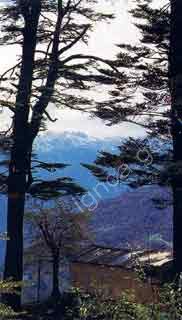
Arunachal Pradesh the 24th state of the Indian Union, is bounded by Bhutan to the west, Myanmar to the east, China to the north and north-east and the plains of Assam to the south. Arunachal Pradesh is acknowledged to be one of the most splendid, variegated and multilingual tribal areas of the world. Arunachal is the largest state (area-wise) in the north-east region. The entire region had remained isolated since 1873 when the British stopped free movement. After 1947, Arunachal became part of the North East Frontier Agency (NEFA). Its strategic significance was demonstrated by the Chinese invasion in 1962, and the Indian government subsequently broke up the agency giving statehood to all the territories surrounding Assam. Arunachal Pradesh finds mention in the literature such as the Kalika Puran and in the epics of Mahabharata and Ramayana. It is believed that sage Vyasa meditated here and also that the remains of the brick structure, scattered around two villages in the hills north of Roing was the palace of Rukmini, the consort of Lord Krishna. The sixth Dalai Lama was also born on the soil of Arunachal Pradesh.
This land, encompassing wide alpine geographical diversity and corresponding climatic conditions varying from tropical to temperate and Alpine, and a wide variety of wild life flora and fauna with concomitant life form, has now started gaining acclaim as a world biodiversity heritage spot. Arunachal Pradesh is endowed with thick evergreen forests with numerous streams, rivers and gorges and hundreds and thousands of species of flora and fauna covering more than 60% of the total area. Its rivers are ideal for angling, boating and rafting and its terrain is suitable for trekking, hiking and holidaying in a serene atmosphere. The upper reaches offer an ideal landscape for promoting adventure tourism of all kinds and are best suited for the tourist, looking for such opportunities. More than 500 species of birds have been recorded, many of which are highly endangered and restricted to this state, such as the white Winged duck, Sclater, Monal bangal florian, etc. Trees of great size, plentiful climbers and abundance of cane and bamboo make Arunachal evergreen. Out of about a thousand species of orchids in India, over 500 are to be found in Arunachal alone. Some of the orchids are rare and classified as endangered. The wildlife is equally rich and varied, which includes elephants, tigers, leopards, jungle cats, white gibbon, red pandas, musk and the “Mithun” (Bos Forntails) exists both in wild and semi domesticated form). The land is mostly mountainous with the Himalayan range along the northern borders criss-crossed with ranges running north- south. These divide the state into five river valleys: the Kameng, the Subansiri, the Siang, the Lohit and the Tirap. All these are snow fed from the Himalayas and so are countless rivers and rivulets. The mightiest of these rivers is the Siang, called the Tsangpo in Tibet, which becomes the Brahmaputra after the Dibang and the Lohit in the plains of Assam joins it. Nature has provided the people with a deep sense of beauty that finds delightful expression in their songs, dances and crafts.
The People
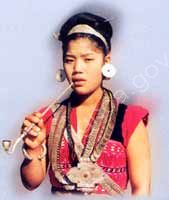 There are 26 major tribes and a number of sub tribes living in the state. Most of these communities are ethically similar having derived from an original common stock but their geographical isolation from each other has brought amongst them certain distinctive characteristics in language, dress and customs.
There are 26 major tribes and a number of sub tribes living in the state. Most of these communities are ethically similar having derived from an original common stock but their geographical isolation from each other has brought amongst them certain distinctive characteristics in language, dress and customs.
The first group of people are the Monpas and the Sherdukpens of Tawang and West Kameng district. They follow the Lamaistic traditions of Mahayana Buddhism. Culturally similar to them are Membas and Khambas who live in the high mountains along the northern borders; Khamptis and Singphos inhabiting the eastern part of the state are Buddhists of Hinayana Buddhism.
The second group of people Adis, Akas, Apatanis, Bangnis, Nishings, Mishmis, Mijis, Tangsas, etc., who worship the sun and the moon namely Donyi Polo and Abotani, the original ancestor for most of these tribes. Their religious rituals largely coincide with the phases or agricultural cycles.
The third group comprises of Noctes and Wanchos, adjoining Nagaland in the Tirap district. They are hard working people known for their structured village society in which the hereditary village chief still plays a vital role. The Noctes also practice elementary form of Vaishnavism.
Social and Cultural Heritage

The whole population of Arunachal can be divided into three cultural groups on the basis of their socio- politico religious affinities.There are three kinds of religions practiced here. The Monpas and Sherdukpens in Kameng and Tawang district, who met the Tibetans in the north, adopted Lamaism of the Buddhist faith, while the Khamptis in Lohit district practice Mahayana Buddhism. The second group, Noctes and Wanchos in Tirap district, whose long association with the Assamese in the south, converted them to Hindus.
They are associated with the practice of head hunting. The third group comprises of Adi, Akas, Apatanis, Nishings, etc.- a large majority of the total population, who maintain their ancient belief and indigenous concepts of nature and worship- the Donyi-Polo (The Sun & Moon).
Apatanis, Hill Miris and Adis make attractive articles in cane and bamboo. The Wanchos are famous for their wood and bamboo carved figurines.
Economy
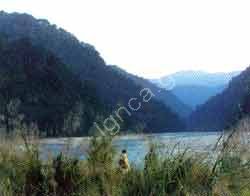 For about 35% of the population of Arunachal Pradesh, agriculture is the main occupation. 17% of total cultivated area is under irrigation. The main crop is rice, grown on valley bottoms and on some terraced slopes. Maize, millets, pulses, potatoes, wheat and mustard are the other important crops. About 62% of the total area of the state is under forests. There is no large scale manufacturing industry, though some coal and lignite are mined. The principal industries are forest based. Forest products, especially bamboo, are vital resources. Saw mills, plywood and veneering mills, rice mills, fruit preservation units, soap and candle manufacturing, steel fabrication, oil expellers are in the medium and small industrial sectors.
For about 35% of the population of Arunachal Pradesh, agriculture is the main occupation. 17% of total cultivated area is under irrigation. The main crop is rice, grown on valley bottoms and on some terraced slopes. Maize, millets, pulses, potatoes, wheat and mustard are the other important crops. About 62% of the total area of the state is under forests. There is no large scale manufacturing industry, though some coal and lignite are mined. The principal industries are forest based. Forest products, especially bamboo, are vital resources. Saw mills, plywood and veneering mills, rice mills, fruit preservation units, soap and candle manufacturing, steel fabrication, oil expellers are in the medium and small industrial sectors.
Deposits of dolomite, ore, limestone, graphite, quartzite, kyanite, mica iron-ore, copper ore have also been reported. Weaving is the universal craft, highly coloured fabrics being made largely by women. The multi coloured masks, fine wood-carving, cane, bamboo and fibre works bear eloquent testimony to the fine artistic temperament of the people. There is a steady export market for Monpa carpets, Adi skirts and Mishmi bags and shawls with a view to develop the traditional handicrafts of the people. The government has established a number of Cottage Industries, Training- cum- production centres, where local boys and girls are trained in various crafts to enable them to earn their livelihood by practicing these crafts. The craft centres are also helping the people in finding markets for their products.
Festivals:
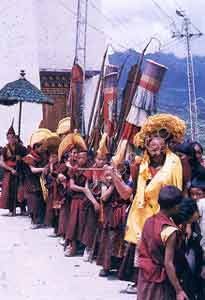
Festivals are an essential part of the socio- cultural life of the people. The festivals are usually connected with agriculture and are associated with ritualistic gaiety either to thank God or to pray for bumper harvest. Some of the important festivals are Mopin and Solung of Adis, Lossar of Monpas & Sherdukpens and Boori-Boot of the Hill Miris, Dree of the Apatanis, Si-Donyi of Tagins, Nyokum of Nishing, Reh of Idu Mishmis, Tamladu of Mishmi, Loku of Nocte, Mol of Tangsa, Sanken of the Khampti and Singpho, Khan of the Miji, Nechi Dau of the Akase of the Tagins, Ojiale of the Wancho, Kshyat-Sowai of the Khowa, Longte Yullo of the Nishing,etc.
Places of Interest:
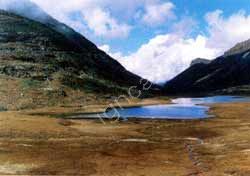
Along, Annini, Bhismaknagar (archaeological sites), Bomdila (at a height of 2530 mts provides a panoramic views of the Himalayan landscapes and snow clad ranges), Changlong, Doparijo, Itanagar (capital, with excavated ruins of historical Ita Fort and attractive Ganga lake [Gekar Sinyi]), Pasighat, Malinithan (archaeological sites), Sessa (orchid park), Namdhapha (wildlife sanctuary in Changlang district), Parasuramkund (place of pilgrimage), Tawang (at a height of 12,000 ft, 400 year old Buddhist Monastery, associated with the famous Torgva festival, is the largest of its kind in the country and is the birth place of the 6th Dalai Lama.), Ziro, Tipi (orchidarium with over 7500 orchids), Akashiganga ( bird’s eye view of the Brahmaputra), Talley Valley ( eco tourism), Roing and Miao.




